How to Make Beet Kvass (Probiotic Beverage)
This post may contain affiliate links. Read my full disclosure here.
This beet kvass recipe creates a healthy drink full of probiotics. Probiotics help boost your immune system and keep your gut healthy.
Beet kvass is an acquired taste, like sauerkraut or other foods made with lacto fermentation. Fresh beets, sea salt and water are naturally fermented to create a lightly salty, mildly acidic beverage. Using a starter culture helps to ensure proper fermentation.
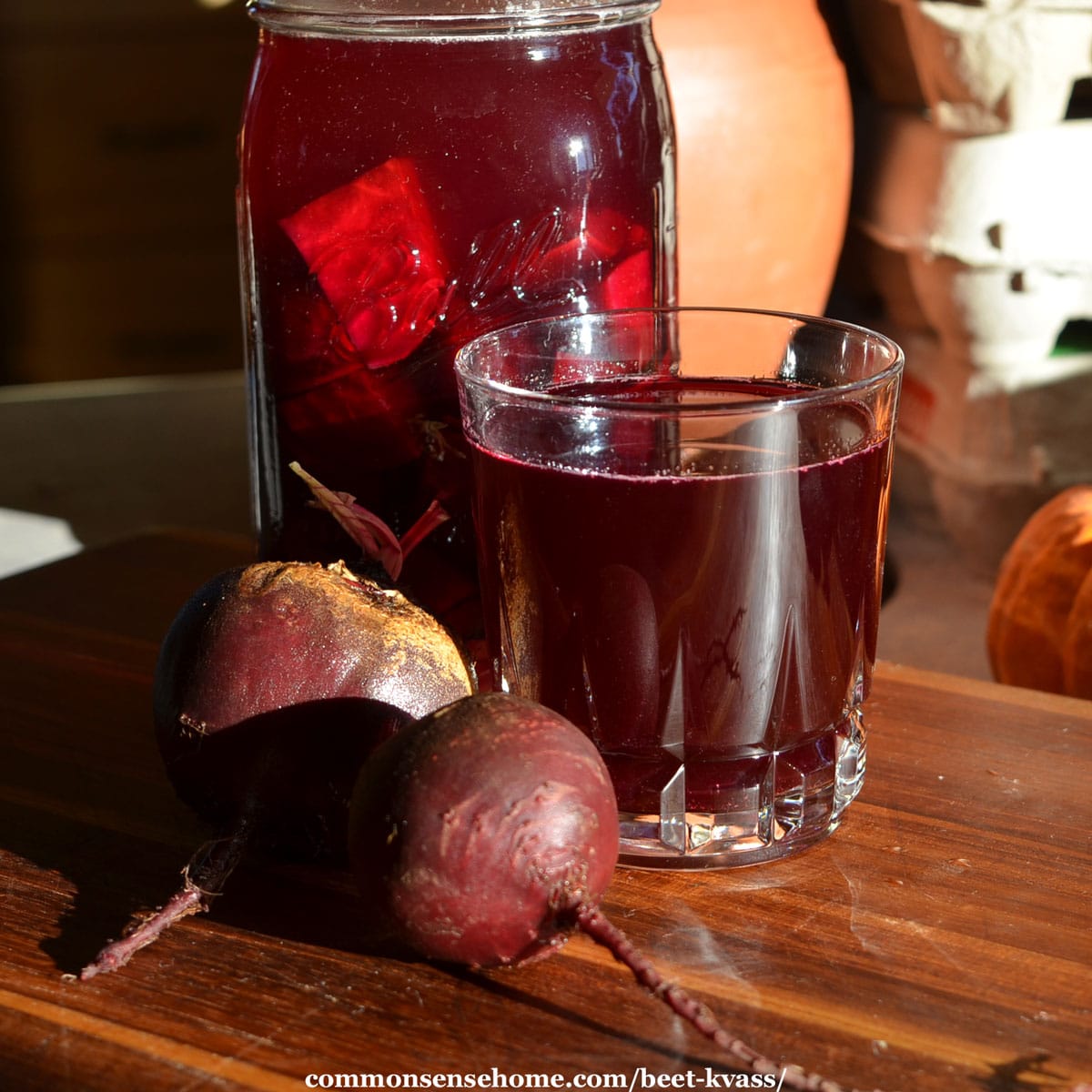
Tips for Making Your Kvass
Since this is a very simple recipe, ingredient quality is extra important.
Watch out for tap water quality. Tap water may contain chlorine, which inhibits fermentation. It’s best to use filtered water or spring water. We use our Berkey filter to remove contaminants, but retain good minerals.
Fresh beets are best for fermenting. The skin of the beet is the best source of the lactic acid producing bacteria we want to cultivate. We want fresh and frisky bacteria, so use your garden beets or those fresh from the farmers market.
If you only have access to beets that have been in storage for a while, the whey or starter culture helps to boost the friendly bacteria content.
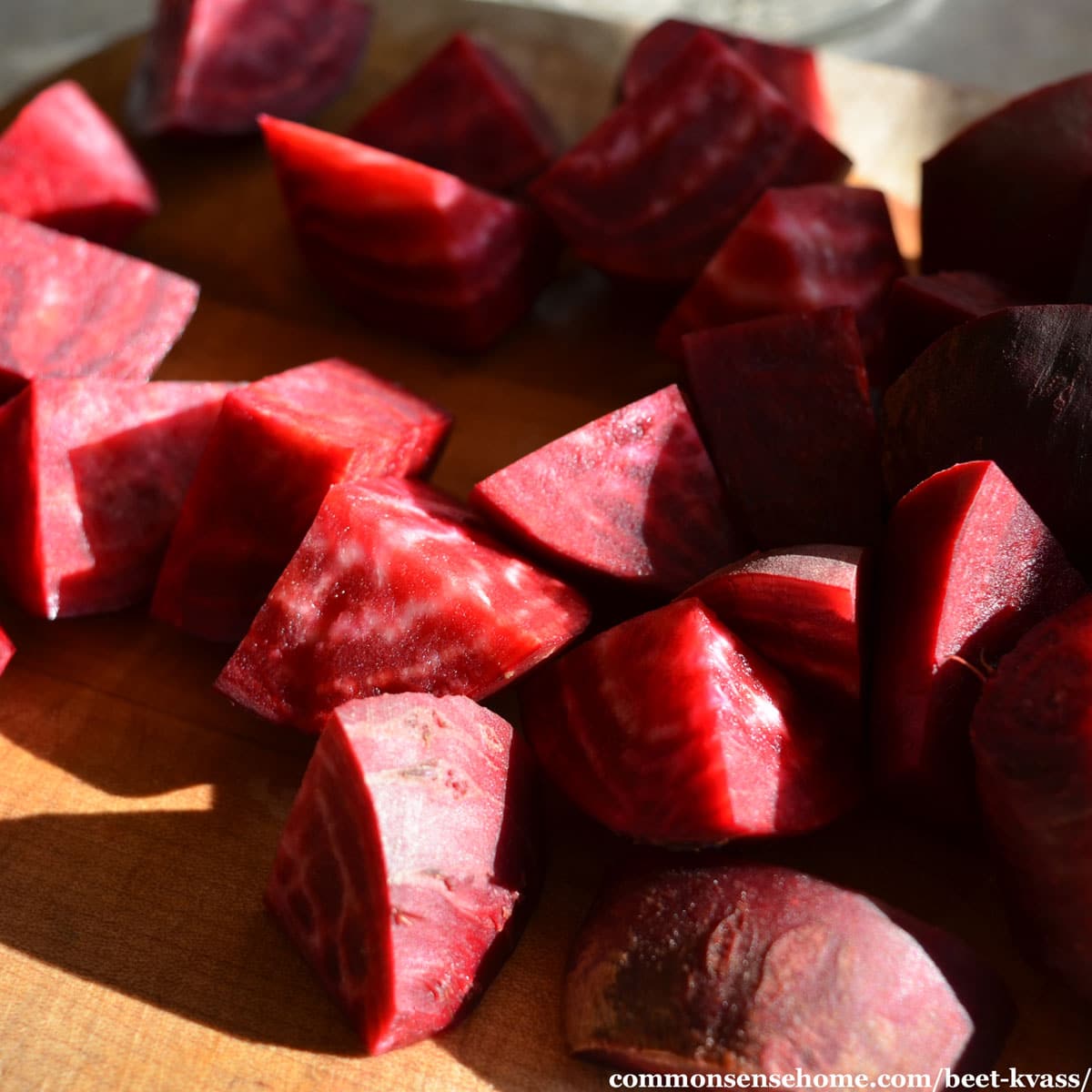
Choose an unprocessed salt like sea salt, Himalayan salt, or Real Salt. Avoid iodized salt, which produces a cloudy ferment.
Room temperature has a HUGE impact on fermentation time. If your kitchen is warm, your beet kvass may be ready in only 2-3 days. In a cool kitchen, you may want to ferment at root temperature for up to two weeks.
If it’s too warm (or you forget to check it) and your ferment gets thick and slimy, compost it. Bubbles and film on the surface are normal. Skim off the film (which is likely kahm yeast) before bottling.
Always ferment in a glass jar or non-reactive container. Your kvass is mildly acidic, so it can interact with metal. I use wide mouth mason jars fitted with an airlock cover.
Airlocks are handy because they keep out microbes from the environment, reducing the risk of spoilage. If you don’t have an airlock, simply use a tight fitting lid and burp daily to vent fermentation gases.
PrintBeet Kvass
Fresh beets, sea salt and water are naturally fermented to create a lightly salty, mildly acidic beverage.
- Prep Time: 5 minutes
- Fermentation Time: 5 days
- Total Time: 120 hours 5 minutes
- Yield: 1 quart 1x
Ingredients
- 3 organic beets (medium – large), cubed but not peeled
- 1 teaspoon sea salt
- 1 quart filtered water
- 2 tablespoons fresh whey or other starter culture, or a packet of commercial starter culture (optional – see notes)
Instructions
- Slice off the bottom of the beet and thoroughly scrub. Coarsely chop the beets and place in a tall glass container.
- Mix together the filtered water, sea salt, whey (or starter culture) and create a brine. Pour the brine over the beets. Cover the container with an airlock or lid and keep at room temperature for 5-7 days, until it tastes sour like pickle juice.
- Strain out the beets and compost or use in other recipes. Transfer the liquid to mason jars and store in the refrigerator for up a month.
Notes
If you don’t use whey or a starter culture, increase the amount of salt to 1 1/2 teaspoons.
Don’t use tap water if it is chlorinated because chlorine will inhibit the fermentation process.
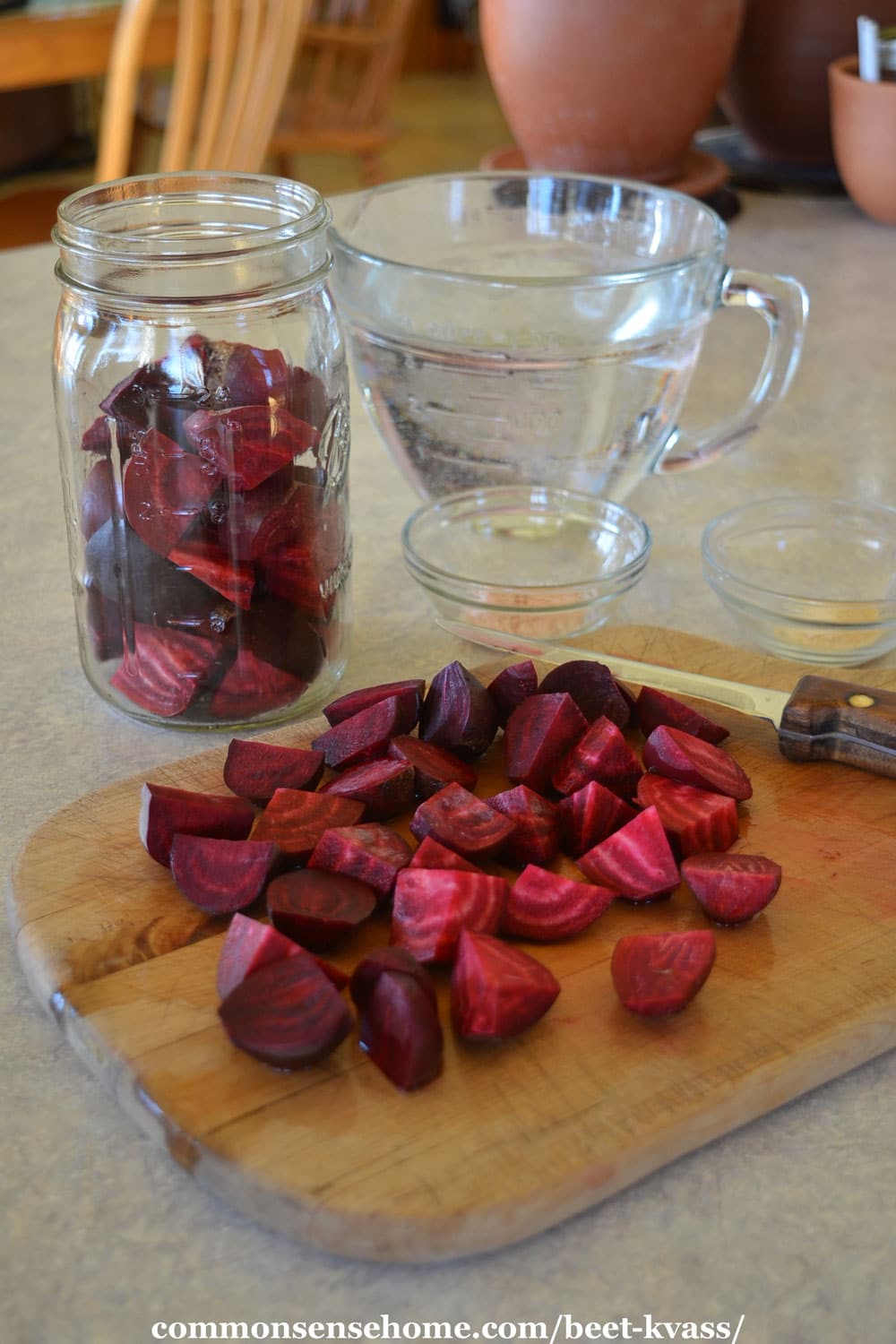
Would you like to save this?
Recipe Variations
If you have a bounty of beets and want to experiment, try mixing in different fruits, veggies and spices. Some ideas include:
- Carrot chunks or oranges, for extra sweetness
- Garlic or pickling spice, for a bolder flavor
- Ginger root slices for more digestive benefits
- Warming spices like cinnamon and cloves
- Using different types of beets, like golden beets or mangel beets
Health Benefits of Beet Kvass
In Nourishing Traditions, Sally Fallon notes, “One four ounce glass in the morning and night, is an excellent blood tonic, promotes regularity, aids digestion, alkalizes the blood, cleanses the liver, and is a good treatment for kidney stones and other ailments.”
Beets are high in many vitamins and minerals: vitamins A, B & C; beta-carotene, beta-cyanine; folic acid, potassium, magnesium, fiber, phosphorus, and iron. They may help lower blood pressure and purify the blood.
Beets contain phytonutrients called betalains, which are anti-oxidant and anti- inflammatory. Fermenting beets converts the nitrates in beets to nitric oxides, which may improve blood flow.
Recent studies show beets boost metabolic health and gut health. Even if you don’t love beets, they are a healthy addition to your diet.
Starter Culture Options
To make sure your beet kvass grows good bacteria, you can jumpstart fermenting with a starter culture.
A starter culture is a source of good bacteria, which speeds up the fermentation process. We can use bacteria from other fermented foods, or buy a commercial starter culture. (I use this culture in the video.)
Some good sources of friendly bacteria include:
- A previous batch of beet kvass, or other kvass
- Sauerkraut juice, or juice from other fermented vegetables
- Whey strained from plain yogurt or kefir with live and active cultures
- Kombucha
- Ginger bugs or other naturally fermented soda
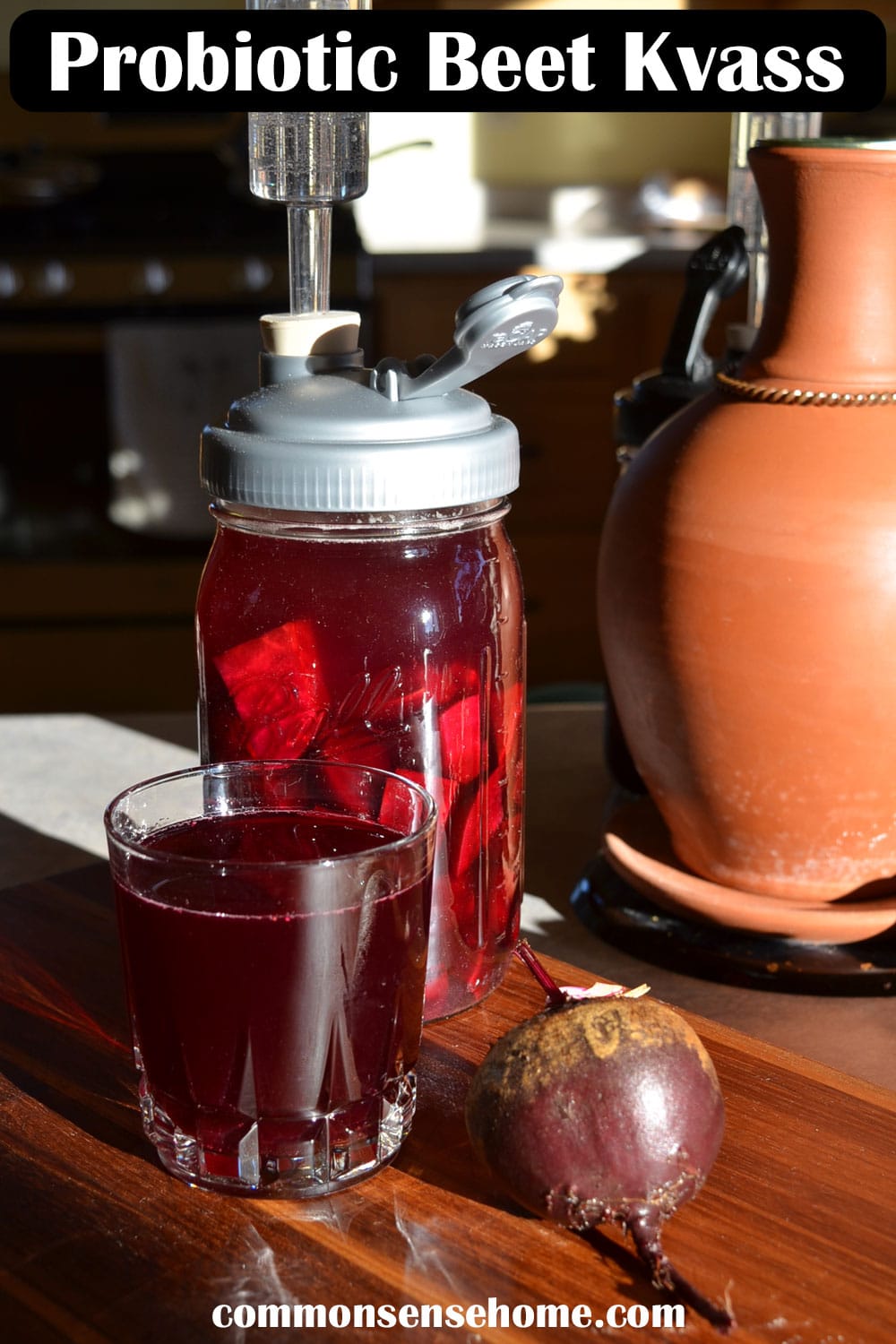
More Probiotic Recipes
Fermented foods are great for gut health, and many are easy to make at home. Some of our favorite ferments include:
- Homemade Sauerkraut
- Pinecone Soda with Wild Yeast
- Holiday Kombucha Flavor Ideas
- Mead Made with Wild Yeast
Originally posted in 2009, last updated in 2022.

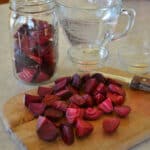
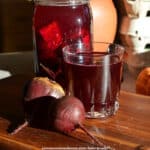
Hi Nerdy Mom. 🙂
Uh-oh on the digging dog. The neighbor's dog ran over some of my melon transplants a couple of years ago, and they were never the same, either.
I should have explained the liquid swap out better. The reason for it is to brew a second batch from the same beets. You pour off most of the first batch of kvass, but leave a little in the bottom of the jars to act as a starter for the second batch instead of just the whey. I did find the second batch to be milder in flavor, but that's just a bonus.
Thank you for this how-to! I am especially inspired by your large beets – the dog dug mine up halfway through the summer, and they were never the same when I tried to replant 'em. Anyway, thanks for the recipe and tips. This has been on my "things to try" list for a while now. One question though, why do you replace some of the kvass with water halfway through the fermenting process? Is it just to give it a milder flavor?
I found you through Tuesday Twister, by the way.
http://mindofthemother.blogspot.com/
Dr. Catherine – Thanks for stopping by and thanks for your kind words. I just added an online link for the jelly strainer to the article. I picked mine up at a local hardware store during canning season and the price was similar (just under $8). I use mine all the time for straining whey, straining jelly, straining chicken stock, straining herbs out of oil – you name it. Very handy piece of equipment, plus the legs unscrew so it can be put away flat, and you can get replacement bags separately when they wear out. The elastic on mine finally gave out last season after 5+ years of use.
I LOVE BEET KVASS! What a great article! I really want to know where to get that cool thing you are straining the whey with, can you share, please?
Blessings!
I am by no means a kvass expert, but I would strongly suspect that you could substitute 1/4 cup of kvass from a previous batch for the whey. After all, it would have all the little critters you're looking to grow. If you give it a try, will you post and let me know how it works?
So I just started my own bottle of kvass fermenting. i am wondering if I have to start over with new whey after the two batches of kvass are made? Or can I use a bit of the previous kvass as a starter for the next batch?
Pamela – I think I figured out how to add it. Thanks for adding my posts to your mix.
Laurie ~ I see you have subscribe by email. But don't see a subscribe RSS Feed. Do you have one and I am just not seeing it?
If you do I'll ad you into my RSS Feed roll for Real Food.
Both my teenagers love the carrots and neither ate pickles before. I think they are a perfect starter ferment for kids because most kids like carrots. Neither of mine will eat sauerkraut either. I have to say I much prefer kimchi to sauerkraut myself.
kc – wow – that's some adventurous fermenting! I'm lucky if I can get my crowd to eat sauerkraut – but I'm working on it. 🙂
Laurie, I really enjoyed this post. As someone from the South, I was never fed beets growing up. I only discovered beets when we started the GAPS diet and now I am a big fan. Beets with daikon radish are currently competing with garlic ginger carrots as my all-time favorite fermented vegetable blend. I like beets in soups, but they are the best for ferments. I can't wait to try this kvass recipe but my only source for beets right now is a grocery store and even there it is hit or miss. Psychic lunch did a post today on beet salad and I talked about them today in my post about fermented vegetables. Cool, huh?
Excellent Post Laurie!!
I've done beet Kvass before but for my husband it's just to salty and he's on a reduced salt restriction. Months later I decided to try beet Kvass using Kombucha with it..figuring the probiotic effects of Kombucha combined with the nturient values of the beets would be great. I loved it my hubby did not. Link to my try is here @ http://seedsofnutrition.com/?p=399.
Say don't toss out the beets after your brewing unless you really can't tolerate the thought of using them – on page 196 in Nourishing Traditions I took the beets after the brewing and made the Russian Beet Salad. It was delicious.
Thanks for the study you shared on Beet Juice. I had never come across that one before in my online searches.
Weeeellllll, unless the family enjoys the taste of beets, it may be a stretch. So far I've got no takers, but I'm hoping to get some to my stepfather (he lives on the other side of the state) who is currently having problems with anemia.
The first batch was very strong flavored, the second was much better, IMHO. The fermentation process seems to have created new flavor profiles, a little bit fruity and floral, less salty and metallic (less beety, if you will).
My hope for a fermented drink that the family will enjoy is in water kefir soda. I have the grains, I just haven't gotten around to rehydrating them and brewing yet. Lately I feel like I'm up to my eyeballs in alligators, just trying to keep up with everything.
I can't wait to try this. I'm saving this link for future reference. My beets are still too small and none yet @ the farmer's market. Does the sweetness of the beets tame down the saltiness and tanginess of the whey? Maybe THIS will be the fermented drink my family will drink?? 🙂
motherhen68 … I feel your pain. I have a family member that hates and refuses almost all ferments other than certain flavors of kombucha or fermented sodas. However, I found that to get him to drink beet kvass I can puree it with a banana, add other fresh fruit and berries, and make him a “probiotic smoothie.” To get him to eat kraut I have to include caraway seeds in the ferment and then I still have to add a little light drizzle of raw honey to his serving.